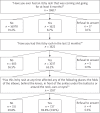Atopic dermatitis is a serious health problem in Poland. Epidemiology studies based on the ECAP study
- PMID: 25821420
- PMCID: PMC4360000
- DOI: 10.5114/pdia.2014.40935
Atopic dermatitis is a serious health problem in Poland. Epidemiology studies based on the ECAP study
Abstract
Introduction: Global epidemiological studies have revealed considerable geographical differences in prevalence of atopic dermatitis (AD).
Aim: To present the epidemiology of AD, risk factors and co-occurrence of allergic diseases in the Polish population.
Material and methods: The present paper is a part of the Epidemiology of Allergic Disorders in Poland study. We studied 22 703 participants by ECRHS/ISAAC questionnaire; 18 617 (53.8% female, 24.2% 6-7 y.o., 25.4% 13-14 y.o., 50.4% 20-44 y.o.) completed questionnaires were accepted. Four thousand seven hundred and eighty-three participants (25.7%) have undergone a medical examination.
Results: Atopic dermatitis was diagnosed in 3.91% (6-7 y.o. 5.34%, 13-14 y.o. 4.3%, adults 3.02%), more often in females (OR = 1.52; 95% CI: 0.56-0.77), in the cities (OR = 2.23; 95% CI: 1.61-3.09), in mothers (OR = 2.07; 95% CI: 1.72-2.48) and fathers (OR = 2.00; 95% CI: 1.61-2.49) with atopy, higher education (OR = 1.61; 95% CI: 1.11-2.32) and economic status (OR = 1.35; 95% CI: 1.04-1.74). The highest prevalence was found in Katowice (4.89%) and lowest in rural areas (1.9%). Coexisting AD and allergic rhinitis (AR) was found in 26.17%, AR and asthma in 9.09% and AD, AR and asthma in 14.6%. Atopic dermatitis was diagnosed by allergologists in 6.5% (6-7 y.o. 8.7%, 13-14 y.o. 9.0%, adults 3.6%). Most diagnoses were made in Poznan (16.76%) and smallest in rural area (3.67%). 78.8% of subjects were diagnosed with AD for the first time although they had earlier experienced its symptoms.
Conclusions: Atopic dermatitis prevalence in Poland is below the mean rate for Europe, but the risk factor profile is similar to other countries. Atopic dermatitis is more frequent in well-educated females with atopic parents and high socioeconomic status and who live in a city.
Keywords: atopic dermatitis; epidemiology; risk factors.
Figures





References
-
- Torres-Borrego J, Molina-Terán AB, Montes-Mendoza C. Prevalence and associated factors of allergic rhinitis and atopic dermatitis in children. Allergol Immunopathol. 2008;36:90–100. - PubMed
-
- Asher MI, Montefort S, Björkstén B, et al. Worldwide time trends in the prevalence of symptoms of asthma, allergic rhinoconjunctivitis, and eczema in childhood: ISAAC Phases One and Three repeat multicountry cross-sectional surveys. Lancet. 2006;368:733–43. - PubMed
-
- Odhiambo JA, Williams HC, Clayton TO, et al. Global variations in prevalence of eczema symptoms in children from ISAAC Phase Three. J Allergy Clin Immunol. 2009;124:1251–8. - PubMed
-
- Harrop J, Chinn S, Verlato G, et al. Eczema, atopy and allergen exposure in adults: a population-based study. Clin Exp Allergy. 2007;37:526–35. - PubMed
-
- Williams H, Stewart A, von Mutius E, et al. Is eczema really on the increase worldwide? J Allergy Clin Immunol. 2008;121:947–54. - PubMed
LinkOut - more resources
Full Text Sources
Other Literature Sources
Research Materials
